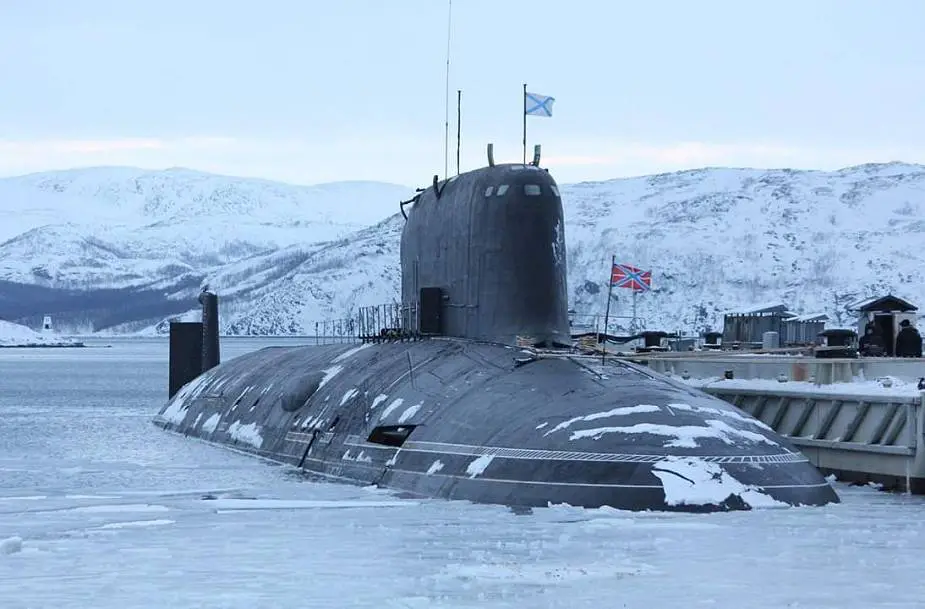Breaking news
Russian Navy Yasen and Yasen-M class SSGN submarines able to fire cruise missile in Arctic region.
Russian Navy Yasen and Yasen-M-class SSGN (Ship, Submersible, Guided Missile, Nuclear) submarines of projects 885 and 885M are able to fire cruise missiles in the Arctic. The Northern fleet held an exercise and the Severodvinsk submarine trained cruise missile fire in the Arctic. It was previously believed that only SSBN can do it. Experts said the engagement of submarines capable of destroying adversary objects on the ground will considerably expand Navy capabilities, the Izvestia daily writes.
Follow Navy Recognition on Google News at this link
 Russian Navy Yasen-class submarine. (Picture source Twitter account Russian Submarine)
Russian Navy Yasen-class submarine. (Picture source Twitter account Russian Submarine)
An attack nuclear submarine sailed to the Arctic for the first time in 15 years. The Severodvinsk was tested in northern latitudes, Defense Ministry sources said. The submariners trained surfacing and submerging, as well as missile fire. The sortie was held in late 2019, but was reported only now.
The Defense Ministry approved the final deployment plan for project 885M SSGN. Five out of seven submarines will operate in the Northern fleet.
It was believed that the Severodvinsk cannot sail under ice, expert Dmitry Boltenkov said. “The submariners have proved that they can do it. It is no surprise that they did not hurry to send the new submarine under ice. Equipment had to be prepared and the crew trained for the complicated sortie,” he said.
Modern submarines have to operate regardless of the latitude and ice situation, Rear Admiral and former submarine commander, Hero of Russia Vsevolod Khmyrov said. “Ice should not be an obstacle in combat. The submarine receives a command to attack and has to fulfill it as soon as possible. Modern submarines operate radars in a surfaced and submerged position. In clear water they can immediately fire from a submerged position. In the Arctic, they fire from loose ice or an ice hole which is to be found or made by breaking the ice with the hull. The tactic demands specific skills. Northern fleet warships sailing in the Arctic have to determine a proper launch area and quickly arrive there,” he said.
Submerged navigation is a dangerous and complicated business. Under ice navigation is twice more dangerous, the expert said. It demands additional training and specialized equipment to see the real situation. Packed ice gets deep underwater and it is necessary to exactly know its depth to avoid a collision. Icebergs pose a major danger, as they have a huge underwater part and constantly drift, Khmyrov said.
The Severodvinsk is the lead SSGN of project 885. Factory trials took three years. Kalibr and Onix missiles were upgraded and tested during the time.
The Navy is to receive several SSGN of the upgraded project 885M soon. They have a modern element base, improved equipment and materials. The Kazan and the Novosibirsk submarines are undergoing trials. Many revolutionary solutions were used in their design. In particular, a new construction was used for the first time. The light hull covers only a part of the solid bow to decrease noise.
Cruise missiles are the main weapon of projects 885 and 885M. The submarines can fire Kalibr and Onix missiles. The former are effective against sea and ground targets and have a range of 1.5 thousand km. Supersonic Onix fights groups and solo warships in heavy electronic warfare and strikes at ground targets. The submarines will be rearmed with hypersonic Tsirkon missiles in future, the Izvestia said.
© Copyright 2020 TASS Navy Recognition. All rights reserved. This material may not be published, broadcast, rewritten or redistributed.


























